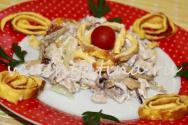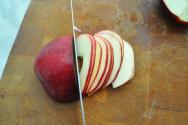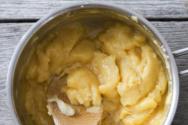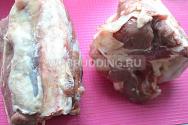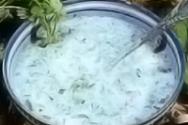Recipe: Spicy-salted Black Sea horse mackerel - Delicious fish. Salted mackerel at home, recipe with photo How to salt mackerel at home
The Black Sea horse mackerel belongs to the Perciformes order of the horse mackerel family. Thanks to the very special structure and arrangement of its scales, this fish is very convenient to clean. The fish is small in size, which also makes it convenient for processing at home. Gourmets will certainly enjoy its special aroma and slightly specific spicy taste.
Select fish for drying of the same size, which should not exceed 15 cm. First, the fish is salted, and then dried. For these purposes, medium-fat sea and low-fat fish are usually used. Dry salting should be used to prepare fish for smoking. To remove excess moisture from the fish, before salting it, you need to wash and dry the horse mackerel.
After this, the dishes for salting are selected. An ordinary ten-liter saucepan may be suitable for this. This pan fits well in the refrigerator. The bottom of the pan is sprinkled with coarse salt. Salt should not be iodized. The salt layer should be 0.5 mm. The fish is laid out in layers, each layer of fish is sprinkled with salt. You should not place the fish to the top edge; be sure to leave a distance of 5 cm to the top. The top layer of fish is sprinkled with salt. The layer thickness should be approximately 1.0 - 1.5 cm.
On top of the last layer of horse mackerel you need to put a wooden board (and if possible, a circle) of wood. For these purposes, you can use a plate or a lid from a small saucepan. A weight is placed on the circle. Its weight should be at least 10-15% of the weight of the fish in the pan. After 3-4 hours, the fish begins to secrete intercellular juice under the influence of salt. It is at this point that the pan is placed in the refrigerator. The temperature in the refrigerator should be +3-5 degrees. The pan should remain in the refrigerator for 2-3 days. After salting, the fish is washed under the tap. The water should be cold. You can rinse the fish in a colander, which is fixed over the sink to drain the remaining water.
Many people do not know how to properly hang a fish, by the tail or by the head. It is best to hang the fish by the lower jaw. To do this, use a regular paper clip. The paperclip needs to be straightened. However, there are no clear rules for hanging fish; everyone chooses a method that is convenient for them. It is better to hang fish on the balcony. The balcony must be closed so that flies do not land on the fish and dust does not fly. Air circulation on the balcony will be much better than in the room.
You can also hang fish on hangers over the eye. If you are going to dry the fish outside, wipe it with gauze soaked in a solution of 9% vinegar. This is necessary to protect horse mackerel from flies. In 4-5 days the fish will be ready. Humidity should be no more than 80% and temperature 20-26 degrees.
If the question is what to cook something original, quickly and, at the same time, inexpensive and not labor-intensive, then salted horse mackerel from the Black Sea is what you need. When choosing fish for salting, it is necessary to take into account that an excellent dish is not obtained from every type of fish, but only from a certain one, which has specific properties, namely, the ability to “ripen”. These are, first of all, herring, salmon, whitefish, notothenia, mackerel, anchovy and mackerel families of fish.
When salting fish, 3 groups of finished products are distinguished in accordance with the mass fraction of salt in the total yield. Thus, lightly salted, medium salted and strongly salted fish are distinguished, where the salt content is 6-10%, 10-14% and over 14%, respectively.
Use in cooking spicy salting Adding coarse non-iodized salt to fish ensures that excess moisture is removed from it. In this way, it is achieved that the product does not impart any taste or preserve it, but that moisture is extracted from the fish due to the slower dissolution of coarse salt crystals at low temperatures compared to fine salt, which, when dissolved, immediately ensures rapid salting of the fish without dehydration. Brine, which is formed during the salting process from a solution of salt and natural juice fish pulp is called brine. The most suitable container for salting horse mackerel is stainless steel, enamel or plastic durable dishes.
Horse mackerel needs to be washed before salting. cold water. Then you need to leave it to ensure the moisture drains, but it is important not to overdry the fish, otherwise it will lose its taste. Next, the fish is placed belly up in a container prepared for salting and sprinkled with salt in layers. Salt consumption is 1 kg per 10 kg of fish. When salting, using a mixture of salt and sugar at the rate of 25-30 g per kilogram of salt gives horse mackerel an extraordinary delicate taste.
Upon completion of laying the horse mackerel, it is covered with a mixture of salt, sugar, preservative and spices and vinegar is added in doses. The use of vinegar speeds up the process of salting fish and lightens its flesh. Then the container with the fish is placed under pressure and placed in a cold place, where the temperature should not exceed 3 - 8 degrees Celsius. As oppression, it is best to use linden or aspen boards, made in the form of circles from a single piece of wood or from sold bars. The use of these types of wood is due to their resistance to deformation in a salty environment and the absence of resin emissions, as well as tannins.
You can salt almost any fish yourself except sturgeon. One of the fish varieties suitable for salting is horse mackerel. Lean meat with a high protein content has a slightly sour taste. This sea fish is great for frying, stewing and salting. Next, we’ll talk about how you can salt horse mackerel yourself.
Spicy salted horse mackerel
Salting of fish can be done at varying degrees of intensity - moderate (160 g per 1 kg of fish) and strong (300 g per kilo of fish). Choose which method you like best. To eliminate the possibility of spoilage of fish during salting, it is necessary to use sodium benzoate (2 g per 1 kg of horse mackerel). This is a food preservative that will prevent fish from spoiling.
Required Products:
- horse mackerel;
- salt, sugar;
- preservative (sodium benzonate);
- a mixture of spices for salting fish;
- table vinegar.
Cooking process:
Before salting, be sure to wash and dry the fish, avoiding drying out. After this, we place the carcasses tightly in an enamel or glassware belly up. Layer by layer we place the fish in a bowl, sprinkling each layer with salt (100 g of salt per 1 kg of horse mackerel).
To give mackerel an unusual delicate taste, you can add a mixture of spices and sugar to the salt for the layer. Spices are mixed in a 1:1 ratio (mixture consumption 25-30 g per 1 kg of table salt). Sugar gives a special delicate taste to the finished product.
After all the fish are placed in the container, cover the fish on top with a thick layer of a mixture of salt, preservative, sugar and pickling spices. To speed up the process of salting fish and make the meat light, add a little table vinegar.
We put oppression on top ( big jar with water) and place in a fairly cool place (5-8°C). For oppression, it is better to take solid wooden circles made from aspen or linden. This tree withstands salty environments well and does not emit resins or tannins.
After a few days, the fish is ready to eat. We remove the oppression, take out the required amount of fish and put the oppression back.
We wash the horse mackerel under the tap, gut it, cut off the head, and cut the carcass into portions. Place the fish in a fan on a plate and garnish with fresh parsley and lemon wedges. Fish can be served as an appetizer or main course. Boiled or baked potatoes with vegetable salad. Bon appetit!
The Black Sea mackerel Trachurus mediterraneus ponticus is a small subspecies of the Mediterranean Trachurus mediterraneus.
This is a Black Sea fish a few minutes after being caught near Gurzuf.
Photo: http://egenika.gallery.ru/
A decrease in the size of individuals in a part of the population that, in one way or another, ends up in a body of water with a smaller volume of water - even if it is quite large in itself - is practically a biological law.
Similarly, the Mediterranean anchovy was crushed in the Black and Azov Seas into anchovy, the Atlantic herring in the Baltic was transformed into a subspecies of Salak, and the smelt, stuck after they were separated from the Baltic Sea, in Ladoga and Onega degenerated into smelt.
At the same time, the new subspecies differ from the original species in taste - due to the different composition of the water of the reservoir that gave them shelter and the differences in the species composition of the food supply in it.
Having settled in the Mediterranean Sea from the Atlantic some thousands of years ago, and then colonized the Black Sea, the horse mackerel has already reached Moscow. In size it is not inferior in the capital yet, but in quality compared to freshly caught fish it is quite obvious 
the lens has become cloudy - and ideally the eyes should be clear, as in the first photo.
But I fell in love with it so much when I lived in Crimea - which was still Ukrainian, and therefore cosmopolitanly common - and I miss it so much that I bought one, with a clouded lens.
Moreover, in the first time after the heroic annexation of the peninsula, horse mackerel was offered in the capital for 1 thousand rubles / kg - and now I saw it at the market on Prazhskaya for 250 rubles: probably Muscovites did not understand it, they did not try it, but they are catching it now in Crimea, without regard to any norms of the maximum permissible seizure, and this overfishing needs to be sold somewhere.
The horse mackerel's intestines turned out to be empty, so I didn't gut the fish - and didn't even rip off the tail scutes 
although for the sake of pomp it would be necessary.
So, without scraping out the tail stems, and placed it on a well-heated frying pan. 
Only I even overheated the oil - and the delicate skin immediately burst.
But this is even good: because it is better that these prickly shields do not get into the mouth - so the skin would still have to be removed. In general, it’s a blast anyway 
But no matter how much I was in a hurry to eat the fried horse mackerel with cold beer, I immediately put some of it aside and dry-salted it with Extra salt 
I place the carcasses crosswise in an enamel container, and a bag - or even two - to make the pan easier to wash later.
And a day later I ran a stream of cold water under the tap: I washed off the remaining salt 
and opened it across the back.
It turned out just great 
Some of the lightly salted ones were eaten immediately, and a few pieces were dried: hung inside the refrigerator on straightened paper clips, clinging to the shelf bars. They hung for 6 days. I took off the hanged ones - but not yet dried: the skin is dry and taut, and the flesh inside is elastic 
Just before eating - and admiring - you need to remove the skin. Use a knife blade to hook it at the base of the dorsal fin and remove it first from one side and then from the other.
And if you don’t remove it, with the shields that stretch along the side line, you can not only scratch your lips, hurt your throat, but also simply choke 
Muscles shine with fat 
It's incredibly delicious, I haven't been this happy in a long time.
I just salted it by eye - so I can’t tell you how much salt to put on 1 kg of fish.
It needs to be lightly salted.
Yes, and one more thing: beer, wine and vodka are not required - although they are usually wonderful on their own - and I really like lightly salted fish with sweet black coffee and a hot egg in a bag.
And these are the scutes on the caudal peduncle that I wrote about above - which you can’t eat, and they definitely need to be torn off 
This is an important systematic feature of the family. Carangidae/syn. Horse mackerel, which also includes horse mackerel, and every time I am surprised how people manage not to notice them - and confuse horse mackerel with a completely obvious and fundamentally different smooth-sided mackerel.
Well, if you are already in Crimea, try both: it is clear that there, freshly caught, they are even tastier than those brought to Moscow.
To begin with, I will give you a recipe for dried (properly dried) Black Sea horse mackerel, because due to its small size, the absence of falling large scales, marine origin and belonging to the order Perciformes, it has a body that is convenient for peeling scales, a specific spicy taste and special aroma. According to “Commodity Research of Food Products” (N.D. Kudentsov, Publishing House “Economy”, M., 1968, p. 115), “dried fish is called fish that has previously undergone a salting process using a cooled brine method or a dry salting method, and then dried for hangers to remove moisture until ready at a humidity of no more than 38%.”
For drying it is better to take Black Sea horse mackerel approximately the same size, at least 10 and up to 15 cm long. For salting and subsequent drying of low-fat and medium-fat sea fish pelagic species, it is better to use the dry salting method.
The horse mackerel must first be washed and dried to remove excess moisture. Then you should choose the dishes for salting.
Personally, I like ordinary household ten-liter saucepans, which can be placed in the refrigerator without any problems. Before salting, you need to pour a 0.5 mm layer of coarse salt (necessarily non-iodized) onto the bottom of the pan (or any other dish). Next, you should lay out the horse mackerel in layers, generously sprinkling each layer of fish with salt so that there is a distance of about 5 cm to the top edge of the container.
The top layer of fish is also sprinkled with salt to a thickness of 1.0 - 1.5 cm. Salts must be used for dry salting of horse mackerel, at least 12-15% of the weight of the fish. A wooden circle (plate, enamel lid, etc.) is placed on top of the last layer of horse mackerel, on which a weight (weight) weighing at least 10-15% of the weight of the fish is placed.
After about 3-4 hours, the fish, under the influence of salt, begins to release natural brine (intercellular juice containing proteins and minerals).
It is at this very moment that the dishes with fish should be placed in the refrigerator at a temperature of +3-5 degrees for 2-3 days. After salting, the mackerel should be carefully washed under running cold water, removing excess brine (you can do this in a large colander, and then leave the fish in it to drain the water).
The question of how to properly hook a horse mackerel, by the tail or by the head, is decided arbitrarily. For example, I like to hang mackerel, hooking it to the lower jaw with a regular paper clip, on the balcony of a high-rise building (6-10 floors), where there is good and stable air circulation.
You can also hang horse mackerel on hangers with flyers in the courtyard of a private house, having previously determined where the breeze constantly blows.
In the latter option, I strongly recommend that you cover the horse mackerel caught through the eye with gauze soaked in 9% vinegar to protect against cheese flies. After 4-5 days, at a temperature of 20-26 degrees and a humidity of no more than 80%, the horse mackerel is well dried. The readiness of horse mackerel is determined as follows: the back is ready dried fish dried, the meat is elastic-hard, when cut it has an even grayish-yellow color, and the caviar is orange-red.
I like to consume dried horse mackerel exclusively according to the Astrakhan classic method, dipping its peeled pulp into a bowl filled with mustard or unrefined sunflower oil.
